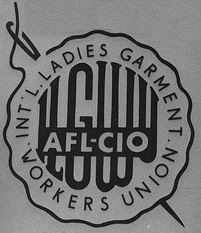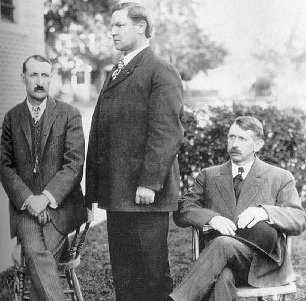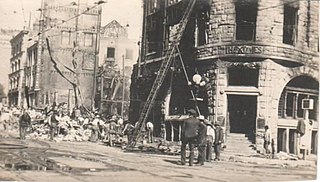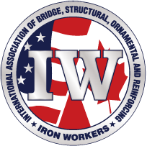
Clarence Seward Darrow was an American lawyer who became famous in the early 20th century for his involvement in the Leopold and Loeb murder trial and the Scopes trial. He was a leading member of the American Civil Liberties Union and a prominent advocate for Georgist economic reform.

The nature and power of organized labor in the United States is the outcome of historical tensions among counter-acting forces involving workplace rights, wages, working hours, political expression, labor laws, and other working conditions. Organized unions and their umbrella labor federations such as the AFL–CIO and citywide federations have competed, evolved, merged, and split against a backdrop of changing values and priorities, and periodic federal government intervention.

Service Employees International Union (SEIU) is a labor union representing almost 1.9 million workers in over 100 occupations in the United States and Canada. SEIU is focused on organizing workers in three sectors: healthcare, including hospital, home care and nursing home workers; public services ; and property services.

William John Burns was an American private investigator and law enforcement official. He was known as "America's Sherlock Holmes" and earned fame for having conducted private investigations into a number of notable incidents, such as clearing Leo Frank of the 1913 murder of Mary Phagan, and for investigating the deadly 1910 Los Angeles Times bombing conducted by members of the International Association of Bridge, Structural, Ornamental and Reinforcing Iron Workers. From August 22, 1921, to May 10, 1924, Burns served as the director of the Bureau of Investigation (BOI), predecessor to the Federal Bureau of Investigation (FBI).

The International Ladies' Garment Workers' Union (ILGWU), whose members were employed in the women's clothing industry, was once one of the largest labor unions in the United States, one of the first US unions to have a primarily female membership, and a key player in the labor history of the 1920s and 1930s. The union, generally referred to as the "ILGWU" or the "ILG", merged with the Amalgamated Clothing and Textile Workers Union in the 1990s to form the Union of Needletrades, Industrial and Textile Employees (UNITE). UNITE merged with the Hotel Employees and Restaurant Employees Union (HERE) in 2004 to create a new union known as UNITE HERE. The two unions that formed UNITE in 1995 represented 250,000 workers between them, down from the ILGWU's peak membership of 450,000 in 1969.

Earl Rogers was an American trial lawyer and professor, who later became the inspiration for Erle Stanley Gardner's fictional character Perry Mason.

Charles H. Moyer was an American labor leader and president of the Western Federation of Miners (WFM) from 1902 to 1926. He led the union through the Colorado Labor Wars, was accused of murdering an ex-governor of the state of Idaho, and was shot in the back during a bitter copper mine strike. He also was a leading force in founding the Industrial Workers of the World, although he later denounced the organization.
The International Typographical Union (ITU) was a US trade union for the printing trade for newspapers and other media. It was founded on May 3, 1852, in the United States as the National Typographical Union, and changed its name to the International Typographical Union at its Albany, New York, convention in 1869 after it began organizing members in Canada. The ITU was one of the first unions to admit female members, admitting women members such as Augusta Lewis, Mary Moore and Eva Howard in 1869.

The Commission on Industrial Relations was a commission created by the U.S. Congress on August 23, 1912, to scrutinize US labor law. The commission studied work conditions throughout the industrial United States between 1913 and 1915. The final report of the Commission, published in eleven volumes in 1916, contain tens of thousands of pages of testimony from a wide range of witnesses, including Clarence Darrow, Louis Brandeis, Mary Harris "Mother" Jones, Theodore Schroeder, William "Big Bill" Haywood, scores of ordinary workers, and the titans of capitalism, including Daniel Guggenheim, George Walbridge Perkins Sr., Henry Ford, and Andrew Carnegie.

The Union Label and Service Trades Department, AFL–CIO was founded on April 12, 1909, to promote the products and services produced in America by trade union members—especially those products and services identified by a union label, shop card, store card and/or service button. The department is a constitutionally mandated department of the AFL–CIO.
Employers Group was founded as the Merchants and Manufacturers Association (M&M) in 1896 in California. It has become a worldwide organization advocating for employers and giving guidance about employment laws and regulations, professional development, consulting projects, and compensation and workplace trends surveys.

The Los Angeles Times bombing was the purposeful dynamiting of the Los Angeles Times Building in Los Angeles, California, United States, on October 1, 1910, by a union member belonging to the International Association of Bridge and Structural Iron Workers (IW). The explosion started a fire which killed 21 occupants and injured 100 more. It was termed the "crime of the century" by the Los Angeles Times newspaper, which occupied the building.

American Lightning: Terror, Mystery, the Birth of Hollywood, and the Crime of the Century is a non-fiction book by Howard Blum, published in 2008.

The International Longshore and Warehouse Union (ILWU) is a labor union which primarily represents dock workers on the West Coast of the United States, Hawaii, and in British Columbia, Canada; on the East Coast, the dominant union is the International Longshoremen's Association. The union was established in 1937 after the 1934 West Coast Waterfront Strike, a three-month-long strike that culminated in a four-day general strike in San Francisco, California, and the Bay Area. It disaffiliated from the AFL–CIO on August 30, 2013.
The Illinois Central shopmen's strike of 1911 was a labor action in the United States of a number of railroad workers unions against the Illinois Central Railroad, beginning on September 30, 1911. The strike was marked by its violence in numerous locations. At least 12 men were killed in shootings across the country, and in March 1912, some 30 men were killed when a locomotive boiler exploded in San Antonio, Texas.
When union violence has occurred, it has frequently been in the context of industrial unrest. Violence has ranged from isolated acts by individuals to wider campaigns of organised violence aimed at furthering union goals within an industrial dispute.
Jake West was an American labor union leader, who was convicted of embezzlement.
James B. McNamara was a 20th-century American labor unionist, best known for his involvement in the McNamara Case as the bomber of the Los Angeles Times building.
Eric M. Dean is an American labor union leader.












